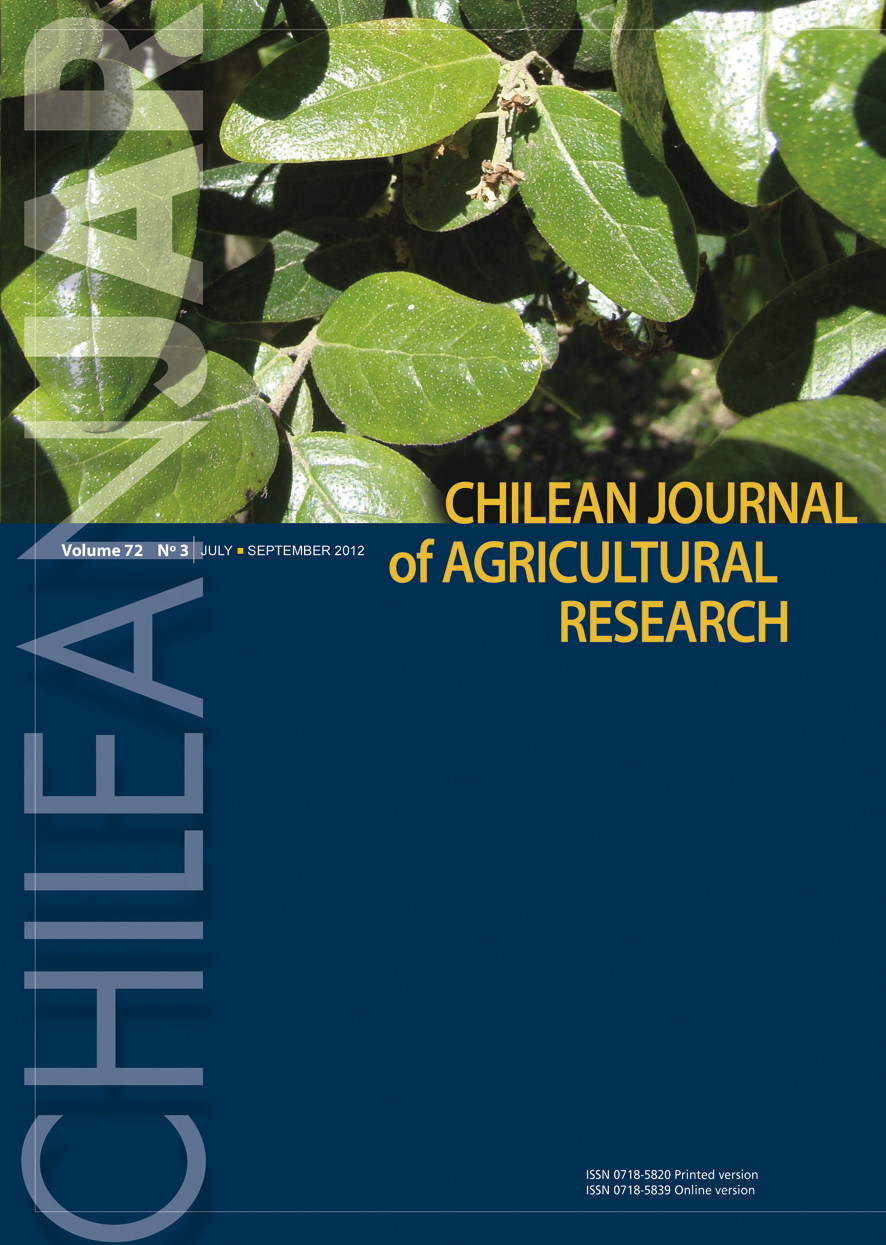
|
Chilean Journal of Agricultural Research
Instituto de Investigaciones Agropecuarias, INIA
ISSN: 0718-5820
EISSN: 0718-5820
Vol. 68, No. 3, 2008, pp. 309-314
|
 Bioline Code: cj08032
Bioline Code: cj08032
Full paper language: English
Document type: Note
Document available free of charge
|
|
|
Chilean Journal of Agricultural Research, Vol. 68, No. 3, 2008, pp. 309-314
| en |
Paclobutrazol For Height Control Of Petunias
Francescangeli, Nora & Zagabria, Ana
Abstract
The effects of paclobutrazol on the height of Petunia × hybrida hort. ex E. Vilm. were studied. An experiment on 'Bravo F1' was performed at the National Institute for Agricultural Technology (INTA), San Pedro Agricultural Experimental Station (33º4’ S, 59º4’ W), Buenos Aires Province, Argentina, in the spring of 2006. Treatments consisted of three colours of flower (white, red and blue), four concentrations of paclobutrazol by irrigation (0, 5, 10 and 15 mg L-1 and three application times (at 10-12, 18-20 and 26-28 leaves). Height at 45 d after transplanting (dat), days to appearance, opening and fall of the first flower and number of flowers at 21 and 45 dat were registered. Differences between control plants due to flower colour were detected, and would indicate the need of a differential management: at 45 dat, the height of red-flowered plants (22.3 cm) was less (P < 0.05) than white- (25.2 cm) or blue-flowered plants (26.4 cm). Paclobutrazol allowed for reducing height in all treated plants. The minimal concentrations that induced maximum effects were: 10 mg L-1 for blue-flowered plants (56% shortening), 5 mg L-1 for white-flowered plants (40% shortening) and 10 mg L-1 for red-flowered plants (38% shortening). In order to minimize the slightly deleterious effects detected in the number of blue and red flowers at 45 dat, early application would be advisable (10-12 leaves) for blue-flowered plants and more delayed (at 18-20 leaves) for red-flowered plants.
Keywords
plant growth regulator, plant architecture, flower colour, application time, Petunia × hybrida.
|
| |
| es |
Paclobutrazol para el control de la altura de petunia.
Francescangeli, Nora & Zagabria, Ana
Resumen
Para estudiar los efectos del paclobutrazol en la altura de petunia (Petunia × hybrida hort. ex E. Vilm.), se desarrolló un experimento sobre el cv. Bravo F1 en la Estación Experimental Agropecuaria San Pedro (33º4’ S, 59º4’ O) del Instituto Nacional de Tecnología Agropecuaria (INTA), Provincia de Buenos Aires, Argentina durante la primavera de 2006. Los tratamientos consistieron en tres colores de flor (blanco, red y azul), cuatro concentraciones de paclobutrazol aplicadas por riego (0; 5; 10 y 15 mg L-1) y tres momentos de aplicación (10-12, 18-20 y 26-28 hojas). Se registraron: altura 45 días después del trasplante (ddt), días a aparición, apertura y caída de primera flor y número de flores a 21 y 45 ddt. Se detectaron diferencias entre testigos debidas al color de flor, resultado que indicaría la necesidad de un manejo diferencial: a 45 ddt la altura de plantas con flores rojas (22,3 cm) fue menor a la de plantas con flores blancas (25,2 cm) o azules (26,4 cm). El paclobutrazol redujo la altura en todas las plantas tratadas. Las concentraciones mínimas con las que se observaron los máximos efectos fueron: 10 mg L-1 para plantas de flor azul (reducción: 56%), 5 mg L-1 para plantas de flor blanca (reducción: 40%) y 10 mg L-1 para plantas de flor roja (reducción: 38%). Para minimizar efectos levemente deletéreos detectados en número de blue flowers y rojas a 45 ddt; sería conveniente para azul una aplicación temprana (10-12 hojas) y para rojo una más tardía (desde 18-20 hojas).
Palabras-clave
regulador de crecimiento, arquitectura de la planta, color de la flor, momento de aplicación, Petunia × hybrida.
|
| |
© Copyright 2008 - Instituto de Investigaciones Agropecuarias, INIA (Chile).
Alternative site location: http://www.inia.cl
|
|
